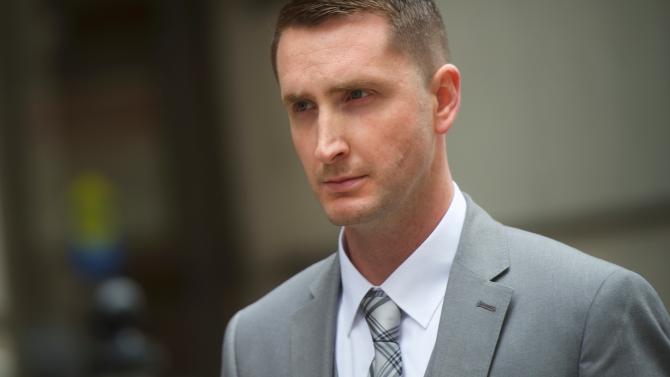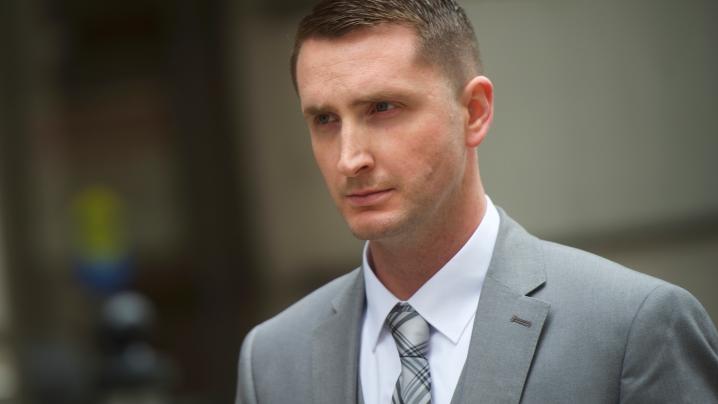[ad_1]

Edward Nero, a Baltimore police officer who was involved in Freddie Gray’s arrest, exits the Baltimore City Circuit Court for a lunch recess during the first day of his trial on May 12, 2016.
Mark Makela/Getty Images
Closing arguments concluded Friday after a weeklong bench trial for Officer Edward Nero in the death of Freddie Gray. The trial for Nero focused less on the facts of how Gray died and more on the particulars of laws regarding detaining, arresting and transporting prisoners, and general orders from the Baltimore Police Department on procedures that should be uniform but that officers don’t always follow.
Gray died in police custody in April 2015 after he was shackled and placed in a police van without a seat belt being properly attached and was subsequently injured during transit.
Judge Barry G. Williams peppered both the prosecution and the defense with questions, interrupting them repeatedly as they gave closing arguments to clarify their statements. This case, which could have an impact on the practice of police arresting citizens without probable cause, could also have broad implications for policing in Baltimore and in other cities around the nation.
The case has the potential to create new laws around policing in the way that the O.J. Simpson trial created new protections for victims of domestic violence and stricter laws for batterers. During Nero’s trial, at least three veteran officers testified that they had never belted detainees, despite general orders to do so and millions of dollars in civil lawsuits for detainees who have been injured in vans.
Tessa Hill-Aston, president of the NAACP’s Baltimore branch, feels that justice has been served by having these police officers face these trials: “We have the police under a magnifying glass, and they are being forced to change internally. It’s unfortunate that it took Gray’s death to have this happen. It’s been something that’s been brewing for a long time.”
Nero is charged with second-degree assault and misconduct in office in connection with Gray’s stop and arrest, as well as reckless endangerment and a second count of misconduct for his role in placing Gray in the van in shackles without fastening his seat belt.
While the defense tried to minimize Nero’s role in the arrest and transport of Gray, the prosecution noted that in Nero’s statement to police, he described the arrest as a team effort.
“‘Miller and I, we got him in custody,’” prosecutor Janice Bledsoe read from his statement during her closing arguments.
“An arrest,” said Bledsoe, “occurs when an officer moves a citizen from one place to another without justification or places a cooperating citizen in the prone position without justification. … Like any citizen, an officer has accessory liability. He is treated no differently than an ordinary citizen.”
Bledsoe said that a stop is permissible for the sole purpose of dispelling or confirming original suspicion and that Nero, along with Officer Garrett Miller and Lt. Brian Rice, elevated a stop to arrest without probable cause and didn’t follow the laws regarding the questioning of detainees and giving them information about why they are being stopped.
Bledsoe also focused on not belting Gray, who was reported to be fully cooperative, and laying him prone after he had complained that he couldn’t breathe. She described what happened to him as an assault.
The defense argued that there was no way to prove that Nero had read the general order that requires officers to place detainees in seat belts and that the responsibility to belt detainees lies with the wagon driver—though that’s not written in the police general order, the prosecution rebutted.
“Once a citizen is taken into custody of a police officer, the officer has a duty to ensure the safety of the citizen. Officer Nero failed to keep Freddie Gray safe,” Bledsoe said.
The defense argued that in a high-crime area, the law allows an officer to detain a suspect if there is unprovoked flight, and the law allows for the suspect to be handcuffed if there is a danger of flight.
“The state has to prove beyond a reasonable doubt that there was an illegal arrest and custody,” said defense attorney Marc Zayon. “What would a reasonable officer do? That’s the standard.”
Zayon said that what happened constitutes a civil case, not a criminal case.
“There’s a difference between a civil case and a criminal case,” said Debbie Hines, a former Baltimore City assistant state’s attorney who has been watching the case closely. “I don’t know if there’s enough to get a criminal conviction based on the evidence in Nero’s case. It didn’t seem like this officer was all that involved in the arrest and detention of Gray. I don’t think the state has proved their case.”
Judge Williams is expected to announce the verdict Monday at 10:30 a.m.
[ad_2]





















